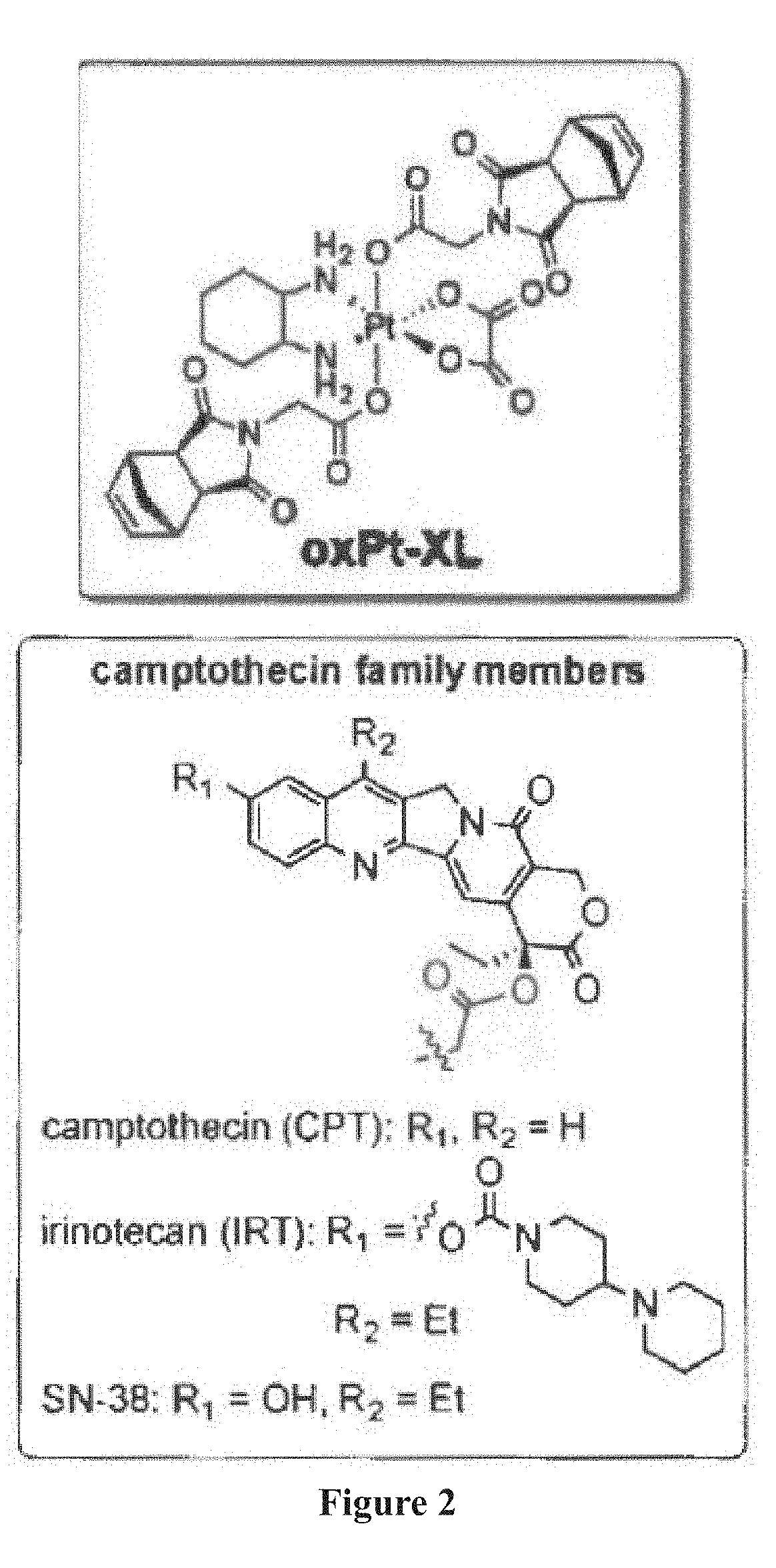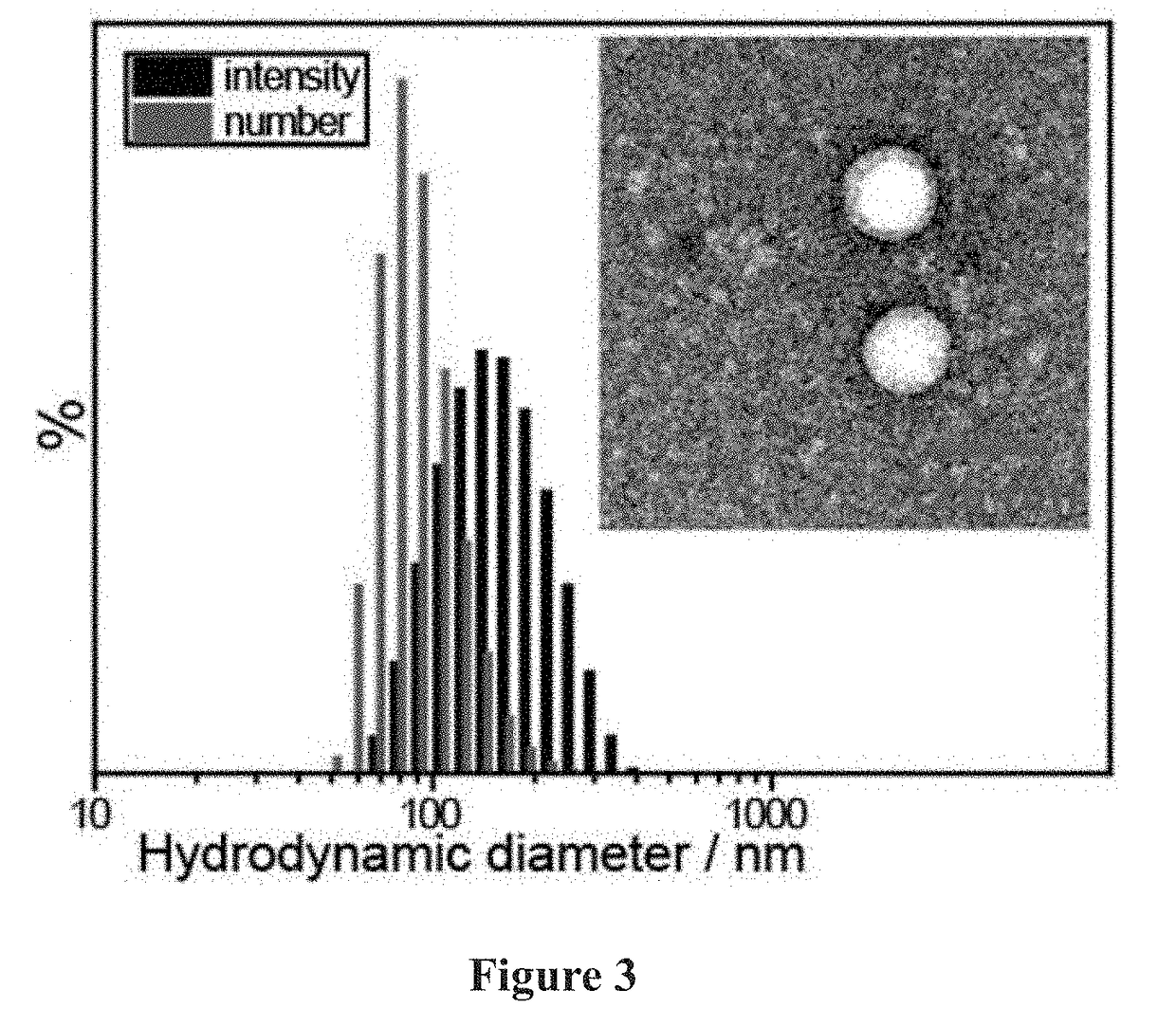Drug delivery polymers and uses thereof
a technology applied in the field of polymerization and macromolecules, can solve the problems of limiting the use of higher doses to achieve the maximum antineoplastic effect, and achieve the effect of low molecular weigh
- Summary
- Abstract
- Description
- Claims
- Application Information
AI Technical Summary
Benefits of technology
Problems solved by technology
Method used
Image
Examples
example 1
in Crosslinker (OxPtXL): Synthetic Protocol
[0344]Oxaliplatin Crosslinker (OxPtXL): A modified procedure was used in the synthesis of OxPtXL (FIG. 8). Norbonene anhydride a2 (551 mg, 1.3 mmol, 4.3 eq), and dihydroxy oxaliplatin-Pt(IV) al (129 mg, 0.3 mmol, 1.0 eq) were dissolved in anhydrous DCM (10 mL). The reaction mixture was allowed to stir under N2 at room temperature for 2 weeks. The mixture was then centrifuged upon the addition of DCM (25 mL); the solid was collected, washed with ethyl acetate (30 mL×3), and followed by centrifugation (3,000 rpm, 7 min). The pure product was collected and dried under vacuum, yielding OxPtXL (197.6 mg, 79%) as a white solid. HRMS-ESI: Calcd for C30H34N4O12Pt: m / z=860.1712 [M+Na]+; Found: 860.1713 [M+Na]+. 1H NMR (400 MHz, DMSO-d6, ppm) δH 8.28 (d, J=8.7 Hz, 2H), 7.78 (t, J=11.2 Hz, 2H), 6.31 (s, 4H), 4.17 (s, 4H), 3.10 (s, 4H), 2.71 (s, 4H), 2.55 (br, 2H), 2.09 (d, J=11.0 Hz, 2H), 1.53 (d, J=9.5 Hz, 4H), 1.44 (br, 2H), 1.33-1.31 (d, J=9.6 Hz, ...
example 2
for Brush-Arm Star Polymer (BASP) Syntheses
[0345]All BASP syntheses were performed in a glovebox under a N2 atmosphere; however, similar results are expected under ambient conditions. All ROMP reactions followed the same general procedure, which was modified from previously published literature1,5
[0346]Chemical Structures of all Macromonomers (MMs) and Crosslinkers (XLs):
[0347]The chemical structures of macromonomers (MMs) and crosslinkers (XLs) used are shown in FIGS. 9A to 9C. The highlighted functional groups of CPT and DOX indicate where the drug is conjugated to the MM.
[0348]General Scheme for Brush Polymerization and Crosslinking to Form BASPs:
[0349]The general scheme for the synthesis of the reported drug-loaded brush, followed by cross-linking with the bis-norbornene functionalized Pt(IV) prodrug to afford brush-arm star polymers (BASPs) is shown in FIG. 10.
[0350]Cisplatin(cisPt)-Doxorubicin(DOX)-Camptothecin(CPT) Nanoparticles:
[0351]The general scheme for the synthesis of ...
example 3
ature Assay
[0375]Heat Map and Principle Component Analysis of UV-Stimulated and Diluted DOX NPs:
[0376]A signature assay heat map (FIG. 14A) illustrating the effect that UV-triggered release of DOX has on the mechanism of action of the three-drug-loaded nanoparticle is shown. The principal components were further analyzed using a principal component analysis (FIG. 14B).
[0377]RNAi Signatures and Classification of Individual Free Drugs, Prodrugs, and Nanoparticles:
[0378]Eμ-Myc p19Ar− / − lymphoma cells were infected at about 30% with GFP-tagged shRNAs. The cells were then treated with drug to kill 80-90% of cells as judged by propidium iodide exclusion via flow cytometry at 48 h. At 72 h GFP positivity was assessed via flow cytometry. Using the RNAi signature approach, the free drug, prodrug, single-drug-conjugated BASPs, and multi-drug conjugated BASPs illustrated in FIGS. 9A-9C were characterized. The signature assay of native DOX and prodrugs DOX-MM and NP-DOX classified (FIG. 20A) ea...
PUM
| Property | Measurement | Unit |
|---|---|---|
| radius size | aaaaa | aaaaa |
| radius size | aaaaa | aaaaa |
| radius size | aaaaa | aaaaa |
Abstract
Description
Claims
Application Information
 Login to View More
Login to View More - R&D
- Intellectual Property
- Life Sciences
- Materials
- Tech Scout
- Unparalleled Data Quality
- Higher Quality Content
- 60% Fewer Hallucinations
Browse by: Latest US Patents, China's latest patents, Technical Efficacy Thesaurus, Application Domain, Technology Topic, Popular Technical Reports.
© 2025 PatSnap. All rights reserved.Legal|Privacy policy|Modern Slavery Act Transparency Statement|Sitemap|About US| Contact US: help@patsnap.com



